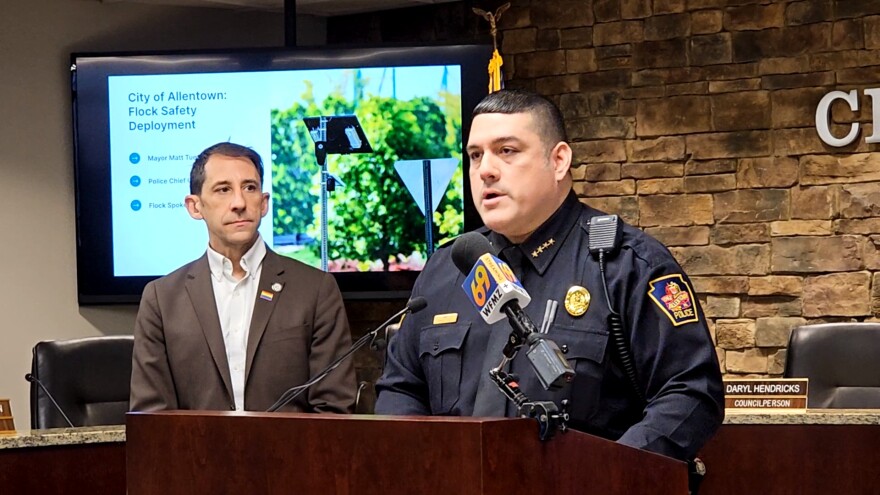ALLENTOWN, Pa. — License-plate readers are being set up throughout Allentown, and one square mile of the city also will be covered by gunshot-detection devices, leaders announced Wednesday.
City Police Chief Charles Roca declined to disclose where those devices are being installed ahead of their imminent activation, which he said will add “a significant tool to our collective toolbox to make our neighborhoods safer.”
Allentown Police Department secured $4.1 million in grants from the Pennsylvania Commission on Crime and Delinquency to buy 67 license-plate readers and several gunshot-detection devices made by Flock Safety.

All license-plate readers are deployed, and city officials hope to finish installing the gunshot-detection devices, known as Raven, in the next few weeks.
The Raven devices can recognize gunshots — and differentiate them from fireworks and other loud noises — up to a quarter mile away, according to the company.
After the device registers a noise as a gunshot, it will record a five-second audio clip that police can use as “actionable, objective evidence” to investigate incidents of gunfire, Flock Safety spokesperson Holly Beilin said Wednesday during a news conference at Allentown City Hall.
License-plate readers in the area of the suspected gunfire also will be “automatically turned on to capture additional visual evidence of the scene,” Roca said. He called that evidence “vitally important.”
Those readers are programmed to determine a vehicle’s make and model and capture still images of its license plate, Beilin said.
The readers also can detect “aftermarket features like a roof rack” but will not take photos of people inside vehicles, she said.
“Not to minimize law enforcement or crime investigation: When you think of Scooby Doo, they talk about finding the clue. This helps us find that clue. And I think it’s important that we will hold that person accountable, regardless of what mask they wear.”Allentown Police Chief Charles Roca
Having that information at the start of a shots-fired investigation can be critical, Roca said.
“Not to minimize law enforcement or crime investigation: When you think of 'Scooby Doo,' they talk about finding the clue. This helps us find that clue,” Roca said.
“And I think it’s important that we will hold that person accountable, regardless of what mask they wear.”
Boosting efficiency
The gunshot-detection technology will help officers respond faster to incidents while also making them more efficient, Allentown Mayor Matt Tuerk said.
Raven devices being installed in Allentown can alert officers to gunshots in less than a minute and identify locations within 90 feet of where those shots were fired, the company says.
That will help police more quickly pinpoint physical evidence, such as shell casings, “thereby freeing resources” for officers to work on another important aspect of reducing crime: community engagement, Tuerk said.
The Raven system has a 90% success rate, Allentown Police Capt. Kyle Pammer told City Council in July.
“We don't believe that data needs to be held for months or even years in order to provide Chief (Roca) and his officers with enough evidence to actually assist in investigations."Holly Beilin, Flock Safety spokesperson
That means 90% of the noises the technology determines to be gunshots actually are gunshots, while 10% of reports are firecrackers, cars backfiring or other similar loud sounds.
Data collected by Flock devices will be stored in searchable databases for 30 days before being “hard-deleted,” she said.
“We don't believe that data needs to be held for months or even years in order to provide Chief [Roca] and his officers with enough evidence to actually assist in investigations,” Beilin said.
Allentown will own all data collected by Flock Safety, which “can never sell or share it with any private third parties,” she said.
Better data, better solutions
The police chief said he hopes the gunshot-detection technology will help erode “apathy” and fear among some residents who don’t report crimes when they see officers responding to incidents.
“When you look at crime data across the country, you know that you're looking at flawed data. So the better the data is, the better that we can respond and develop strategies to address the problems we actually face.”Allentown Mayor Matt Tuerk
“One of my hopes is to break through any apathy that might be out there or concerns of retaliation,” he said.
Statistics on the number of incidents involving gunfire in 2024 could be higher than other years, as the Raven system may alert police to some incidents that would have gone unreported otherwise, Tuerk said.
But the mayor said new data will more accurately show the extent of Allentown’s problem with guns and help officials better allocate resources.
“When you look at crime data across the country, you know that you're looking at flawed data,” he said. “So the better the data is, the better that we can respond and develop strategies to address the problems we actually face.”
Allentown could eventually expand its gunshot-detection technology to cover more of the city. Putting gunshot-detection devices throughout Allentown would “be fantastic … if resources were infinite,” Tuerk said.



